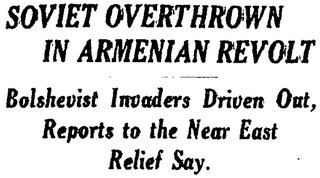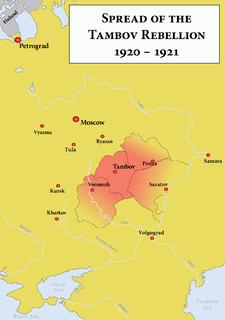 W
WThe August Uprising was an unsuccessful insurrection against Soviet rule in the Georgian Soviet Socialist Republic from late August to early September 1924.
 W
WThe East Karelian Uprising and the Soviet–Finnish conflict 1921–1922 were an attempt by a group of East Karelian separatists to gain independence from the Russian Soviet Federative Socialist Republic. They were aided by a number of Finnish volunteers, starting from 6 November 1921. The conflict ended on 21 March 1922 with the Agreements between the governments of Soviet Russia and Finland about the measures of maintenance of the inviolability of the Soviet–Finnish border. The conflict is regarded in Finland as one of the heimosodat – "Kinship Wars".
 W
WThe February Uprising was an anti-Bolshevik rebellion by the nationalist Armenian Revolutionary Federation which started on February 13 and was suppressed on April 2, 1921 by the recapture of Yerevan by Bolshevik forces.
 W
WGuba Uprising— the uprising against the Soviet occupation in 1920. Hamdulla Afandi Afandizadeh, Kachak Mail, and ADR army officer Afandiyev were leaders of the uprising which lasted about three weeks/ Aliheydar Garayev and Levan Gogoberidze were delegated to the region to suppress the uprising. After weeks of unequal clashes, the rebels were defeated/ During supression of the uprising, the Bolsheviks burned many villages and killed 400-500 peasants.
 W
WThe Kronstadt rebellion or Kronstadt mutiny was an insurrection of the Soviet sailors, soldiers and civilians of the port city of Kronstadt against the Bolshevik government of the Russian SFSR. It was the last major revolt against the Bolshevik regime on Russian territory during the Russian Civil War that ravaged the country. The revolt began on March 1, 1921, in the city's naval fortress, located on the island of Kotlin in the Gulf of Finland. Traditionally, Kronstadt served as the base of the Russian Baltic fleet and as defense for the approaches to Petrograd, located 55 kilometres (34 mi) from the island. For sixteen days, the rebels rose in opposition to the Soviet government they had helped to consolidate.
 W
WThe Left SR uprising or Left SR revolt was an uprising against the Bolsheviks by the Left Socialist Revolutionary Party in July 1918. The uprising started on 6 July 1918 and was claimed to be intended to restart the war with Germany. It was one of a number of left-wing uprisings against the Bolsheviks that took place during the Russian Civil War.
 W
WThe left-wing uprisings against the Bolsheviks, known in anarchist literature as the Third Russian Revolution, were a series of rebellions, uprisings, and revolts against the Bolsheviks by oppositional left-wing organizations and groups that started soon after the October Revolution, continued through the years of the Russian Civil War, and lasted into the first years of Bolshevik rule of the Soviet Union. They were led or supported by left-wing groups such as some factions of the Socialist Revolutionary Party, Left Socialist-Revolutionaries, Mensheviks, and anarchists. Generally, the uprisings began in 1918 because of the Bolshevik assault on soviet democracy, the signing of the Treaty of Brest-Litovsk, and opposition to Bolshevik socioeconomic policy. The Bolsheviks grew increasingly hard-line during the decisive and brutal years following the October Revolution. These rebellions and insurrections occurred mostly during and after the Russian Civil War, until around 1924, though there did exist various small-scale insurgencies until World War II.
 W
WThe Livny Uprising was one of the first peasant insurrections to arise against the Russian Soviet Socialist Republic.
 W
WThe Revolt of the Czechoslovak Legion comprised the armed actions of the Czechoslovak Legion in the Russian Civil War against Bolshevik authorities, beginning in May 1918 and persisting through evacuation of the Legion from Siberia to Europe in 1920. The revolt, occurring in Volga, Ural, and Siberia regions along the Trans-Siberian Railway, was a reaction to a threat initiated by the Bolsheviks partly as a consequence of the Treaty of Brest-Litovsk. One major secondary consequence of victories by the Legion over the Bolsheviks was to catalyze anti-Bolshevik activity in Siberia, particularly of the Committee of Members of the Constituent Assembly, and to provide a major boost for the anti-Bolshevik or White forces, likely protracting the Russian Civil War.
 W
WThe Sheksna uprising was an anti-Bolshevik uprising in townships on the Sheksna River in the Vologda and Cherpovets provinces between 1–3 December 1918. The rebels seized the railway station Sheksna and broke railway communication on the Cherepovets-Vologda line, jeopardizing messages to Petrograd. The uprising was suppressed by Red Army troops arriving from Vologda and Cherpovets.
 W
WThe Tambov Rebellion of 1920–1921 was one of the largest and best-organized peasant rebellions challenging the Bolshevik regime during the Russian Civil War. The uprising took place in the territories of the modern Tambov Oblast and part of the Voronezh Oblast, less than 300 miles southeast of Moscow.